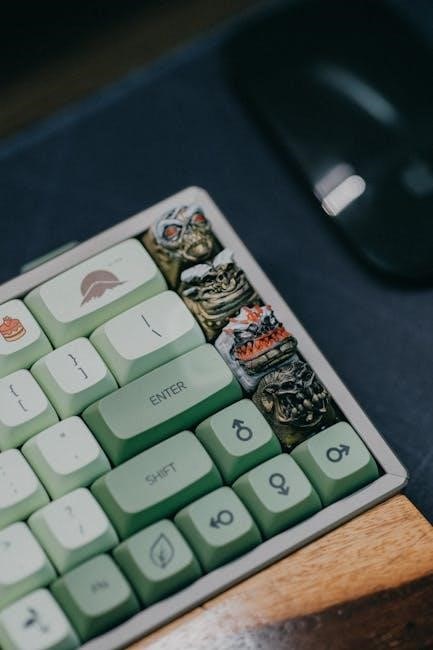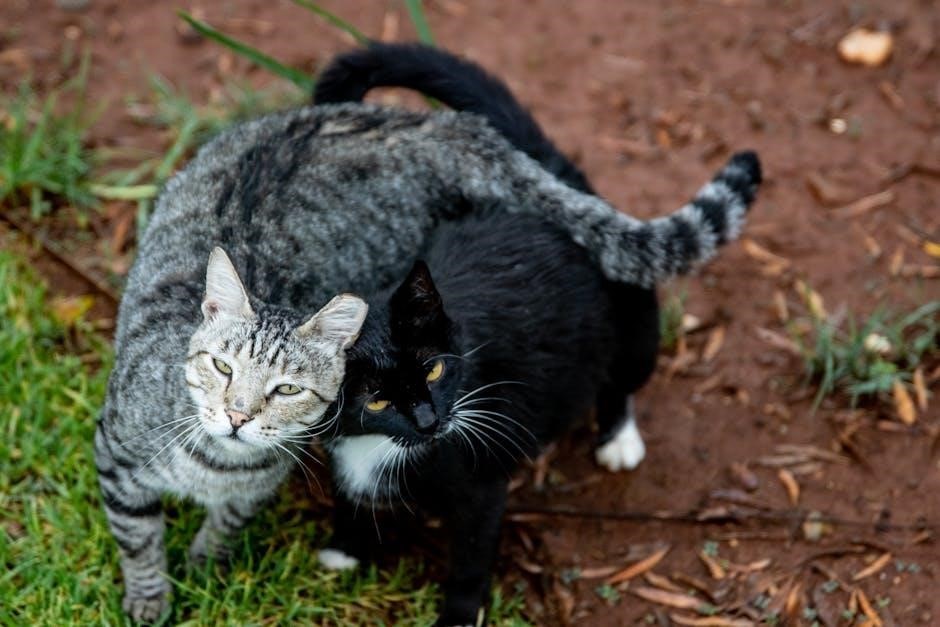Explore the fundamentals of mouse genetics and two-trait inheritance with the Gizmo simulation․ This interactive tool helps students understand genetic principles like dominant and recessive genes, dihybrid crosses, and the 9:3:3:1 ratio, providing a hands-on approach to learning Mendelian inheritance patterns through fur color and eye color traits․
1․1 Importance of the Gizmo Answer Key in Genetics Education
The Gizmo Answer Key is a vital resource for students and educators studying mouse genetics, particularly when exploring two-trait inheritance․ It provides clear, step-by-step solutions to simulations, ensuring understanding of complex genetic principles․ The key not only reinforces concepts like dominant and recessive traits but also offers visual explanations, making abstract ideas more tangible․ By aligning with the Gizmo’s interactive experiments, the answer key enables self-assessment and identifies knowledge gaps․ Its structured format supports diverse learning styles, while its comprehensive coverage of two-trait genetics ensures mastery of foundational concepts․ This tool is indispensable for engaging with the material effectively and confidently․
1․2 Overview of Mouse Genetics: Fur Color and Eye Color
Mouse genetics often focuses on observable traits like fur color and eye color, which are controlled by specific genes․ Fur color in mice is typically determined by the interaction of genes such as B (black) and b (brown), while eye color is influenced by genes like C (pigmented) and c (albino)․ Dominant alleles, like B and C, will always express their traits if present, while recessive alleles, like b and c, only express when no dominant allele is present․ These traits are inherited independently, following Mendel’s laws of segregation and independent assortment, making them ideal for studying genetic inheritance patterns in educational settings․ This simplicity aids in understanding complex genetic principles․
1․3 The Role of Dominant and Recessive Genes in Two-Trait Inheritance
Dominant and recessive genes play a crucial role in two-trait inheritance, determining how traits like fur color and eye color are passed down․ Dominant alleles will always express their trait when present, while recessive alleles only express in the absence of a dominant allele․ In two-trait inheritance, each parent contributes two alleles for each trait, leading to predictable phenotypic ratios․ This interaction is fundamental to understanding how multiple traits are inherited together, as seen in mouse genetics simulations․ The Gizmo answer key provides clear explanations of these genetic interactions, helping students grasp how dominant and recessive genes influence outcomes in dihybrid crosses․

Genetics Basics: Key Concepts
Genetics basics include understanding heredity principles, genetic terms, and processes․ These concepts form the foundation for analyzing inheritance patterns in two-trait simulations and real-world genetics․
2․1 Genotype and Phenotype: Understanding Genetic Makeup

In genetics, the genotype refers to the genetic makeup of an organism, consisting of the specific genes it possesses․ For mice, this includes genes determining fur color and eye color․ The phenotype, on the other hand, is the physical expression of these genes, such as brown fur or black eyes․ Understanding the relationship between genotype and phenotype is crucial for predicting inheritance patterns․ The Gizmo answer key provides exercises to analyze how genotypes (e․g․, BB, Bb, or bb) translate into observable phenotypes․ This understanding helps in simulating two-trait inheritance and interpreting results effectively․ The distinction between genotype and phenotype forms the backbone of genetic analysis in the Gizmo simulation․
2․2 Alleles: Definition and Role in Inheritance
Alleles are alternative forms of a gene that occupy the same position on a chromosome․ They determine specific traits, such as fur color or eye color in mice․ Dominant alleles are expressed when present, while recessive alleles only show their effect in the absence of a dominant allele․ The combination of alleles (e․g․, BB, Bb, or bb) forms the genotype, influencing the phenotype․ In the Gizmo simulation, alleles are used to predict inheritance patterns in two-trait crosses․ Understanding alleles is fundamental for analyzing genetic probabilities and outcomes, making them a cornerstone of genetic inheritance studies in the Mouse Genetics Gizmo․
2․3 Punnett Squares: A Tool for Predicting Trait Inheritance
Punnett squares are a essential tool in genetics for predicting the probability of trait inheritance․ They visually represent the combination of alleles from two parents, helping to determine the likelihood of offspring traits․ In the Mouse Genetics Gizmo, Punnett squares are used to simulate two-trait crosses, such as fur color and eye color․ By arranging the alleles of each parent, students can predict the genetic outcomes and compare them with experimental results․ This method simplifies complex genetic calculations, making it easier to understand inheritance patterns and probabilities․ Punnett squares are a cornerstone of genetic analysis, providing a clear and intuitive way to study trait inheritance in mice․
2․4 Probability in Genetics: Calculating Trait Outcomes
Probability plays a crucial role in genetics, enabling the calculation of trait outcomes based on genetic inheritance․ By analyzing allele combinations, scientists determine the likelihood of specific traits appearing in offspring․ In mouse genetics, probabilities are calculated using Punnett squares or mathematical formulas․ For two-trait inheritance, probabilities are multiplied to find combined outcomes․ The Gizmo answer key provides exercises to practice these calculations, ensuring students understand how genetic probabilities apply to real-world scenarios․ This skill is vital for predicting results in breeding experiments and interpreting genetic data accurately․ Mastering probability in genetics enhances the ability to make informed decisions in genetic research and analysis․

Exploring the Mouse Genetics Gizmo
The Mouse Genetics Gizmo is an interactive simulation that allows users to explore genetic inheritance through virtual breeding experiments․ It provides a hands-on learning experience, enabling students to visualize how traits are passed down and understand core genetic principles․ The Gizmo supports the development of critical thinking skills by allowing users to predict and analyze outcomes in a controlled environment․ This tool is an essential resource for engaging with complex genetic concepts in an accessible and interactive way․
3․1 Features of the Two-Trait Gizmo Simulation
The Two-Trait Gizmo Simulation offers an interactive platform for exploring genetic inheritance with two distinct traits, such as fur color and eye color in mice․ It allows users to select specific genotypes for parent mice and simulate breeding experiments․ The simulation displays the expected phenotypic ratios and enables comparisons between theoretical predictions and actual results․ Key features include customizable traits, real-time data tracking, and tools for analyzing offspring outcomes․ Users can also experiment with different combinations of dominant and recessive alleles to observe how they influence inheritance patterns․ This hands-on approach makes complex genetic concepts accessible and engaging for learners of all levels․
3․2 Navigating the Gizmo Interface: A Step-by-Step Guide
Navigating the Two-Trait Gizmo Simulation is straightforward, with an intuitive interface designed for ease of use․ Begin by selecting the traits you wish to study, such as fur color and eye color․ Choose the genotypes of the parent mice by clicking on the dropdown menus․ Use the simulation controls to initiate breeding and observe the offspring․ The interface displays the phenotypic ratios and allows you to toggle between generations․ Additional tools, such as the genotype checker, provide insights into allele combinations․ A help section is also available for guidance․ This user-friendly design ensures learners can focus on understanding genetic principles without getting lost in complex navigation․
3․3 Simulating Breeding Experiments with Two Traits
Simulating breeding experiments with two traits in the Gizmo allows users to explore genetic inheritance interactively․ Choose two traits, such as fur color and eye color, and select the genotypes of the parent mice․ The simulation displays the expected phenotypic ratios based on Mendelian genetics․ Users can cross mice with different genotypes and observe the offspring’s traits․ The Gizmo also enables users to conduct multiple trials to see how genetic probabilities play out over several litters․ This hands-on approach helps learners visualize how dominant and recessive alleles interact in two-trait inheritance, reinforcing concepts like the Law of Independent Assortment and dihybrid crosses․

The Answer Key: Structure and Support
The Gizmo answer key provides structured support, offering correct answers, explanations, and examples to guide students through genetic concepts and problem-solving․
4․1 Components of the Mouse Genetics Answer Key
The Mouse Genetics Answer Key is a comprehensive resource designed to support learning and assessment․ It includes correct answers to all activities, detailed explanations of genetic concepts, and step-by-step solutions to complex problems․ The key is organized by section, aligning with the Gizmo’s simulations, making it easy for students to follow․ It also provides visual aids, such as Punnett squares and trait inheritance charts, to clarify complex genetic principles․ Additionally, the answer key highlights common mistakes and offers tips for avoiding errors, ensuring a deeper understanding of two-trait inheritance and dihybrid crosses․ This structured approach helps students verify their work and reinforce their knowledge of mouse genetics effectively․
4․2 Using the Answer Key for Self-Assessment and Learning
The Mouse Genetics Answer Key serves as an invaluable tool for self-assessment and learning․ Students can compare their answers with the provided solutions to identify strengths and areas needing improvement․ The key offers detailed explanations for complex genetic problems, helping learners understand underlying concepts․ By reviewing mistakes, students can clarify misunderstandings and reinforce their grasp of two-trait inheritance․ The answer key also includes tips for avoiding common errors, making it a practical resource for independent study․ Regular use of the key enhances problem-solving skills, builds confidence, and prepares students for more advanced genetic studies․ It fosters a deeper understanding of genetic principles through iterative learning and feedback․
4․3 Common Questions and Solutions in the Answer Key
The Mouse Genetics Answer Key addresses frequently asked questions and provides clear solutions to common challenges․ Students often inquire about interpreting phenotypic ratios, setting up Punnett squares for two-trait crosses, and understanding genotype-to-phenotype relationships․ The key offers step-by-step guidance for these topics, ensuring clarity and precision․ For instance, it explains how to distinguish between dominant and recessive traits in complex crosses and how to calculate probabilities for specific offspring outcomes․ By addressing these questions, the answer key helps learners overcome obstacles and solidify their understanding of genetic principles․ It serves as a reliable resource for resolving confusion and mastering two-trait inheritance concepts effectively․
Two-Trait Inheritance: Core Principles
Two-trait inheritance involves the simultaneous study of two genes, such as fur and eye color in mice․ It demonstrates how alleles from different genes assort independently, influencing offspring traits and ratios․
5․1 Dihybrid Crosses: Understanding Two-Trait Inheritance
Dihybrid crosses involve the inheritance of two traits simultaneously, offering insights into how genes interact․ In mouse genetics, this often involves traits like fur color and eye color․ When two purebred mice with different traits are crossed, their offspring (F1 generation) typically exhibit dominant traits for both characteristics․ Self-pollination or interbreeding of the F1 generation produces an F2 generation with a predictable 9:3:3:1 phenotypic ratio․ This demonstrates the independent assortment of genes and the interaction of dominant and recessive alleles․ The Gizmo answer key provides detailed explanations and simulations to help students visualize and analyze these outcomes, reinforcing genetic principles through practical examples․
5․2 The Law of Independent Assortment: Basis of Two-Trait Inheritance
The Law of Independent Assortment, formulated by Gregor Mendel, states that genes for different traits segregate independently during gamete formation․ This principle is crucial for understanding two-trait inheritance, as it allows for the prediction of genetic outcomes when two characteristics are considered․ In mouse genetics, this law explains how alleles for fur color and eye color are inherited independently․ The Gizmo simulation illustrates this concept by enabling students to observe how alleles for two traits separate and combine․ By analyzing the outcomes, learners can verify the law’s application and understand its role in generating genetic diversity․ The answer key provides clarity on how this law applies to dihybrid crosses․
5․3 Predicting Offspring Traits with Punnett Squares
Punnett squares are essential tools for predicting the genetic outcomes of crosses, particularly in two-trait inheritance․ By arranging the alleles of each parent, students can visualize how traits combine․ In the Gizmo, learners can create Punnett squares for mouse genetics, simulating crosses like BBbb or BbEe․ The answer key provides step-by-step guidance on constructing squares and interpreting results․ This method helps estimate phenotypic ratios, such as 9:3:3:1, and verifies predictions with experimental data․ The simulation reinforces understanding of genetic probabilities and Mendelian inheritance, making complex concepts accessible․ The answer key also resolves common misconceptions, ensuring accurate predictions and deeper comprehension of two-trait genetics․

Mendelian Genetics: Foundation of Inheritance
Mendelian genetics forms the cornerstone of inheritance studies, explaining how genes transmit traits across generations․ Its principles, like segregation and independent assortment, underpin the Gizmo’s two-trait simulations․

6․1 Mendel’s Laws: Segregation and Independent Assortment
Mendel’s Laws of Segregation and Independent Assortment are fundamental to understanding inheritance․ The Law of Segregation states that alleles separate during gamete formation, ensuring each gamete receives one allele per gene․ The Law of Independent Assortment explains that genes for different traits are distributed independently during gamete formation․ These principles are crucial for predicting outcomes in two-trait inheritance, as seen in the Mouse Genetics Gizmo․ By simulating dihybrid crosses, students can visualize how these laws apply to traits like fur and eye color in mice, making complex genetic concepts accessible and engaging for learners․
6․2 Monohybrid vs․ Dihybrid Crosses: Key Differences
Monohybrid and dihybrid crosses differ in the number of traits analyzed․ A monohybrid cross involves one trait, such as fur color, and follows Mendel’s Law of Segregation․ It predicts a 3:1 phenotypic ratio in offspring․ In contrast, a dihybrid cross examines two traits simultaneously, like fur and eye color, and applies the Law of Independent Assortment․ This results in a 9:3:3:1 phenotypic ratio․ Understanding these crosses is essential for analyzing two-trait inheritance in the Mouse Genetics Gizmo․ The Gizmo’s simulations allow students to observe these patterns firsthand, reinforcing genetic principles and their practical applications in predicting offspring traits․
6․3 The Role of Dominance in Shaping Phenotypes
Dominance plays a crucial role in determining phenotypes, as dominant alleles mask the expression of recessive alleles․ In mouse genetics, this is evident in traits like fur and eye color․ For instance, a dominant allele for black fur (B) will override a recessive brown allele (b), resulting in a black phenotype․ Similarly, dominant eye color alleles determine visible traits․ The Gizmo illustrates this through simulations, allowing users to observe how dominant and recessive interactions shape offspring traits․ Understanding dominance is vital for predicting phenotypic outcomes in both monohybrid and dihybrid crosses, making it a cornerstone of genetic analysis in the Mouse Genetics Gizmo․

Dihybrid Crosses in the Gizmo
The Gizmo allows interactive simulation of dihybrid crosses, enabling users to explore two-trait inheritance patterns․ It simplifies complex genetic principles into observable, hands-on learning experiences for better understanding․
7․1 Setting Up a Dihybrid Cross in the Simulation
Setting up a dihybrid cross in the Gizmo involves selecting two traits, such as fur color and eye color, and choosing the genotypes of the parent mice․ Users can pick from dominant and recessive alleles for each trait, creating combinations like BBbb, BbBb, or bbBB․ The simulation allows customization of allele symbols and dominance relationships, providing flexibility for different scenarios․ After selecting the parents, users can set the number of offspring to observe and toggle between random or sequential mating․ The Gizmo also offers options to reset or repeat the cross, making it easy to explore various genetic outcomes․ This feature-rich interface ensures a comprehensive understanding of two-trait inheritance patterns․
7․2 Analyzing the 9:3:3:1 Ratio in Offspring

The Gizmo simulation allows users to observe and analyze the classic 9:3:3:1 phenotypic ratio resulting from a dihybrid cross․ This ratio emerges when two traits are inherited independently, adhering to Mendel’s Law of Independent Assortment․ The simulation displays the offspring distribution in a grid, categorizing them based on their phenotypes for both traits․ Users can toggle between phenotypic and genotypic ratios, as well as view a pie chart for visual clarity․ By running multiple trials, users can see how the simulated results align with the theoretical 9:3:3:1 ratio, reinforcing their understanding of probability in genetic inheritance․ This hands-on approach simplifies complex genetic concepts․
7․3 Comparing Theoretical and Experimental Results
The Gizmo allows users to compare theoretical predictions with experimental outcomes, enhancing understanding of genetic inheritance․ Theoretical results are based on Mendelian laws, such as the 9:3:3:1 ratio in dihybrid crosses․ By running simulations, users can collect experimental data on offspring traits and compare it to the expected ratios․ The Gizmo provides tools like bar graphs and pie charts to visualize these comparisons․ This feature helps students understand how genetic probabilities translate into real-world outcomes․ By repeating experiments, users can observe how experimental results align with theoretical predictions over multiple trials, reinforcing the statistical nature of genetic inheritance․ This comparison is a key learning opportunity in the Gizmo․
Interactive Exploration with the Gizmo
The Gizmo offers an engaging, interactive platform for exploring mouse genetics through hands-on activities and simulations, making complex genetic principles accessible and fun for learners of all levels․
8․1 Breeding Mice with Specific Traits: A Hands-On Approach
The Gizmo allows users to engage in interactive breeding experiments with mice, selecting specific traits such as fur color and eye color․ By choosing dominant and recessive alleles for each trait, learners can simulate matings and observe offspring outcomes․ The intuitive interface enables users to input genotype combinations and predict phenotypic ratios․ This hands-on approach helps students grasp the relationship between genotype and phenotype, reinforcing genetic principles like dominance and recessiveness․ The Gizmo also provides visual representations of allele combinations, making complex inheritance patterns easier to understand and analyze․
8․2 Experimenting with Different Genotype Combinations
The Gizmo allows learners to explore various genotype combinations for two traits, such as fur color and eye color․ By selecting different alleles for each parent mouse, users can observe how genetic combinations influence offspring traits․ This feature enables experimentation with homozygous and heterozygous pairings, demonstrating the role of dominant and recessive genes․ The simulation provides immediate feedback, showing the expected phenotypic ratios and genotype probabilities․ This hands-on exploration helps students understand how different genetic combinations result in predictable inheritance patterns, reinforcing the principles of Mendelian genetics․ It also encourages critical thinking about genetic diversity and probability․
8․3 Repeating Experiments to Understand Genetic Probabilities
Repeating experiments in the Gizmo helps users grasp genetic probabilities by observing consistent patterns over multiple trials․ By breeding mice with the same genotypes multiple times, learners can see how genetic variation manifests in offspring․ The simulation highlights the role of chance in inheritance, as identical crosses can yield different outcomes․ This repetition reinforces the probabilistic nature of genetics, allowing users to compare results with theoretical predictions․ Over time, the observed ratios align with expected probabilities, demonstrating the reliability of genetic principles․ This hands-on approach deepens understanding of how genetic traits are inherited and prepares students for advanced topics in genetic analysis․
Analyzing Offspring Outcomes
Evaluate offspring traits to identify patterns and ratios, comparing observed results with theoretical predictions to deepen understanding of genetic inheritance principles in mouse genetics simulations․
9․1 Observing Phenotypic Ratios in the Gizmo
The Gizmo allows users to observe phenotypic ratios in offspring, helping to visualize genetic inheritance patterns for two traits like fur color and eye color․ By simulating crosses, students can record and analyze the proportions of different phenotypes, comparing them to expected Mendelian ratios․ This hands-on approach clarifies how dominant and recessive genes interact․ The interface provides tools to track data, making it easier to identify trends and deviations from theoretical predictions․ Observing these ratios in real-time enhances understanding of probability and genetic principles, reinforcing key concepts in mouse genetics and inheritance․
9․2 Verifying Genetic Probabilities Through Multiple Litters
The Gizmo enables users to verify genetic probabilities by breeding multiple litters of mice, allowing for the observation of consistent patterns in phenotypic outcomes․ By repeating breeding experiments, students can collect data across several generations, ensuring statistically significant results․ This process helps confirm the expected phenotypic ratios, aligning with Mendelian inheritance principles․ Multiple litters provide a clearer understanding of how genetic probabilities manifest over time, reducing the impact of random chance․ The Gizmo’s interactive nature makes it easier to grasp the relationship between theoretical predictions and real-world genetic outcomes, enhancing comprehension of inheritance patterns in two-trait scenarios․
9․3 Understanding Gene Interaction Through Offspring Analysis
Analyzing offspring in the Gizmo provides insights into how genes interact to produce specific traits․ By examining the inheritance of two traits, such as fur color and eye color, students can observe how different alleles influence each other․ This interaction helps explain deviations from expected phenotypic ratios, revealing patterns like epistasis or incomplete dominance․ The Gizmo allows users to manipulate genotypes and observe the resulting phenotypes, enabling a deeper understanding of genetic interactions․ This hands-on approach simplifies complex inheritance concepts, making it easier for learners to grasp how multiple genes contribute to an organism’s traits․ Practical analysis fosters a clearer understanding of genetic principles and their real-world implications․

Educational Benefits of the Gizmo
The Gizmo enhances STEM education by providing an interactive platform for students to explore genetic principles through hands-on experiments, fostering deeper understanding and engagement with complex concepts․
10․1 Enhancing Understanding of Genetic Principles
The Gizmo provides an engaging platform for students to explore genetic principles, such as dominant and recessive traits, through interactive simulations․ By allowing users to breed virtual mice with specific traits, the tool simplifies complex concepts like dihybrid crosses and independent assortment․ Students can observe how different genotypes result in varied phenotypes, fostering a deeper understanding of inheritance patterns․ The visual and hands-on approach makes abstract genetic principles more tangible, encouraging active learning and critical thinking․ This interactive method not only enhances retention but also motivates students to experiment and explore genetic outcomes, solidifying their grasp of foundational genetic concepts in a fun and immersive way․
10․2 Supporting STEM Education Through Interactive Learning
The Mouse Genetics Gizmo is a powerful tool for fostering STEM education by integrating interactive learning into genetics studies․ By simulating real-world genetic experiments, students engage in hands-on activities that promote scientific inquiry and problem-solving․ The Gizmo encourages learners to explore cause-and-effect relationships, test hypotheses, and analyze data, all of which are essential STEM skills․ Its interactive nature makes complex genetic concepts accessible and engaging, motivating students to delve deeper into scientific principles․ This approach not only strengthens foundational knowledge but also cultivates critical thinking and collaboration, preparing students for future challenges in science, technology, engineering, and mathematics․
10․3 Preparing Students for Advanced Genetics Concepts
The Mouse Genetics Gizmo serves as a stepping stone for students to transition into advanced genetics concepts․ By mastering two-trait inheritance through interactive simulations, students build a strong foundation in genetic principles․ The Gizmo’s hands-on approach fosters critical thinking and analytical skills, enabling learners to tackle complex topics like epistasis, polygenic traits, and gene mapping․ Exposure to detailed Punnett squares and dihybrid crosses prepares students for understanding more intricate genetic mechanisms․ This tool bridges the gap between basic and advanced genetics, equipping students with the confidence and knowledge to explore specialized areas of genetics in higher-level courses․
